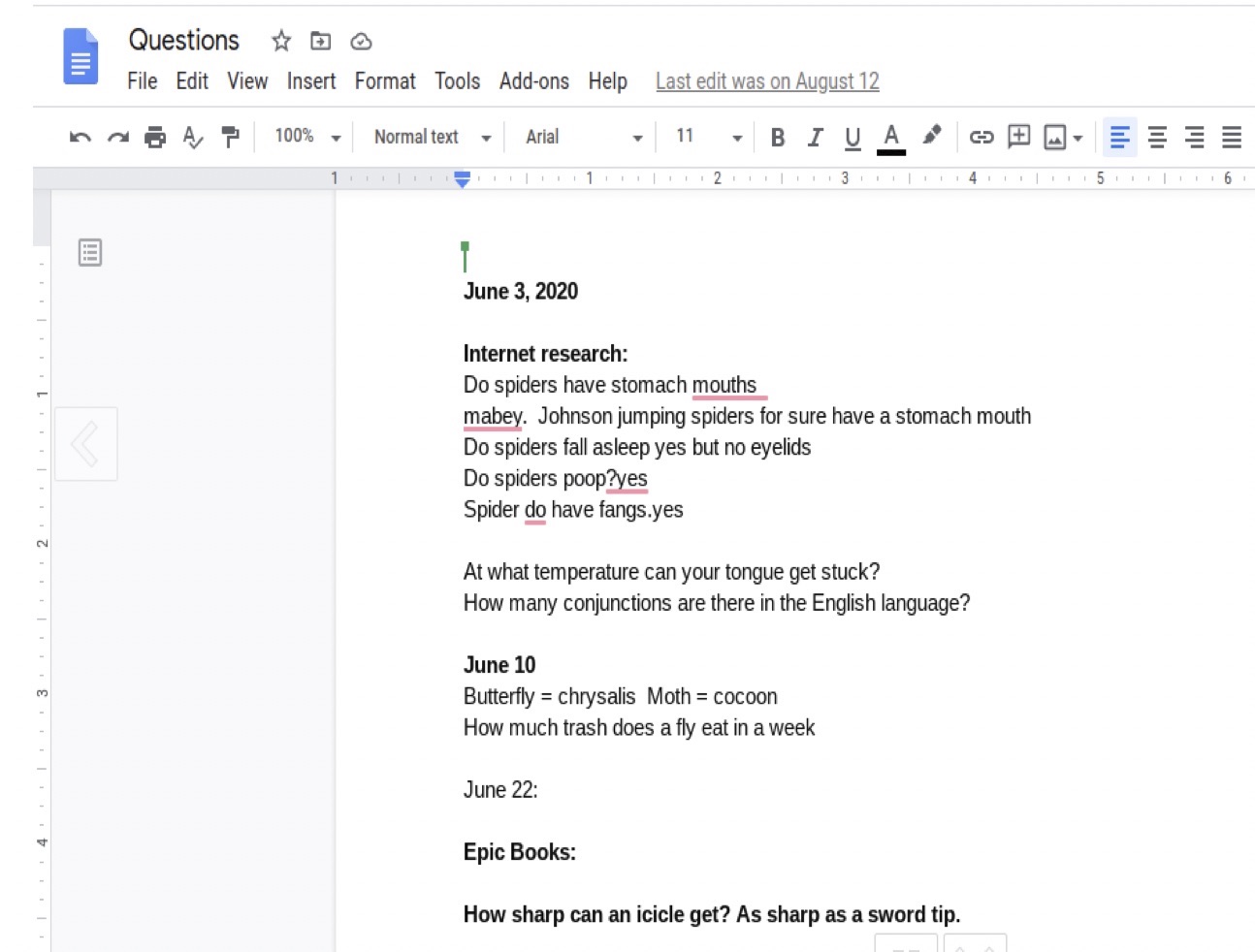The Awesome Power of Simple Questions
 By Mary Beth Nicklaus
By Mary Beth Nicklaus
Everybody has questions.
Sometimes even our questions have questions.
~J from Manila, Philippines (Hello Poetry website)
Harper has questions.
Harper, my fourth-grade virtual tutee, is my awesome question connection.
I met Harper last spring when the colleges here in Wisconsin created an e-tutor collaborative program in response to the COVID-19 pandemic. The program networked tutor and tutees who then got together during the quarantine. These students needed a little extra help after we were all thrown into remote learning that fateful Monday in March.
I sign on as a tutor. Little did I know what gift was in store for me by way of my meeting the thoroughly delightful Harper.
(Harper, sitting in the place where we have been meeting virtually since last spring.)
During our first session together I learn that Harper is a connoisseur of questions.
Whatever we are reading, whatever we are doing, Harper enthusiastically stops us, mid-activity, with “Wait, I thought of a new question!!”
Harper becomes my teacher. His questions become exciting opportunities for research. “Do spiders have stomach mouths? Do they sleep? Let’s google it!!!!” We start a document called the “question” document.

Our learning journey begins with simple compelling questions drawn from reading I Survived the Children’s Blizzard. “At what temperature do our tongues get stuck to metal?” “Why are chokecherries called “choke” cherries?”
He not only grows in his question building ability, but he is soon examining the questions of others. In a later session he tells me he has discovered an error in an online quiz. We create a note letting the site know of the incorrect answer. We spend half an hour crafting the note. I find that Harper’s writing ability is growing as well. I help with punctuation and conventions, he chooses words. Here is the revised note:
In your article, ”WHY DO WE GET GOOSEBUMPS?” the answer to the second question in the quiz is wrong. You have that the correct answer is “Adrenaline and hypothalamus are both produced by the left frontal lobe.” This is incorrect. The correct answer is,
The hypothalamus is the part of the brain that produces adrenaline.
I have learned many things during my time with Harper. He has taught me the power and beauty of simple questions and that they can be found at the root of some serious learning.
All questions have value.
As a teacher of middle schoolers I have spent most of my career promoting higher-order thinking in my students. We tend to focus on the inferential while automatically eschewing the literal in order to bring students to Bloom’s taxonomy fruition. But all this time there is something amiss in our discussions. That is, some students take to this while others sit in the back of the room dazed and left out.
This eats at me. Sometimes I will repeat and use the same questions to try to draw in the unengaged students. Or I may repeat the same questions only with different words. We continue on with the discussion and they stay left out. When we go virtual, it seems even worse. There is something ominous in all of this…these silent black squares with names.
What to do? How can we ignite a flame that leaves no part of the classroom in darkness?
Those empty square students haunt me now more than ever.
I think of Harper’s simple questions. “What is the worst blizzard in the history of the U.S?” “Why do moths fly to light?” In making use of these questions – writing them down, making predictions, researching them, talking about what we found – we automatically fly to the land of higher order thinking.
I don’t force it. Harper just kind of floats us there. “What is the difference between a cocoon and a chrysalis?” A moth comes from a cocoon and a chrysalis gives rise to a butterfly. One flies in darkness towards the light, and one flies in full daylight to gather their nourishment.
When it comes to asking and answering questions, what is it that will make our middle school students CRAVE the light enough to become engaged and gather knowledge on their own?
(Felyx, one of our silent square middle school students from last spring who emerged to show us his new puppy)
Our younger students have an innate hunger for the light. Can we turn our middle school students to the light of learning and give them a desire to drink deeply from the font of knowledge? How can we stretch that excitement for inquiry into the middle school years?
With more of an emphasis on simple questions, I notice the quiet squares slowly light up and emerge into real students who have things to say.
This year I’m learning a whole new set of skills as an online teacher in our district’s virtual school.
I’ve already been working with students online, but tomorrow will be my first virtual class of the year. I will use simple questions to engage my new learners:
✻ I will focus on using simple questions in games like Kahoot or Gimkit.
✻ I will take small pieces of engaging text and have students (instead of me) create questions to jump start discussions.
✻ I will start most online classes with a brain teaser or question. I will mix my brainteasers with ones contributed by students.
✻ I will model myself trying to figure out the answers to questions, often.
✻ I will use the excitement created by answering questions to launch into learning activities.
Finally, in honor of Harper, my students and I will regularly celebrate questions and let the laughter and excitement soothe our souls.
Mary Beth Nicklaus is a literacy specialist and 6th grade virtual teacher this year for Wisconsin Rapids Public Schools in Wisconsin. She is a contributor to Larry Ferlazzo’s Classroom Q and A column for Education Week Teacher.







































Amazing and wonderful blog from my dear colleague, Mary Beth Nicklaus. So many teachers will benefit from this gifted teacher’s talent and commitment to reaching and engaging all learners in challenging and meaningful work. Bravo!
Great ideas!